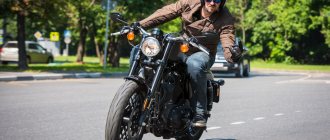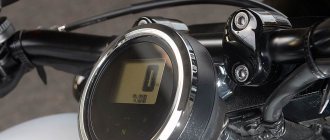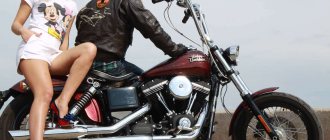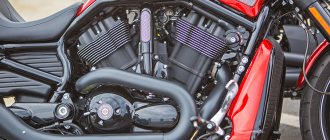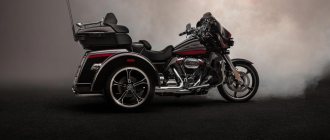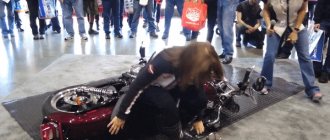Fat Boy survived the Great Purge of 2022, which wiped out many of the Softail and Dyna lineups and led to their merger. The FLSTF joins the rest of the 2022 Softail lineup with a new frame and a choice of the 107 or 141 Milwaukee-Eight engine. Several design features clearly identify the new Fatboys as members of the New Team Harley Davidson.
Harley Davidson Fat Boy Design
The Harley Davidson Fat Boy cruiser has existed as a concept since 1988, but its triumphant announcement took place in the movie Terminator 2, when Arnie saved the world with it.
Low, wide and dangerous - that’s how he seemed, and that’s how he is to this day. The heavy appearance is an illusion created by the visual heaviness of the wheels on solid Lakester wheels. Yes, wheels milled from a single casting look cool, but anyone who has ridden one of these knows how they float and how much the waves from heavy trucks move on them.
The front fender has been slightly reduced, but the appearance remains just as massive. The fork is dressed in classic “beer can” casings that protect the crowbars from dirt and damage. Closer to the crossbeam, classic solutions are combined with new design trends in the headlight: the old square housing houses a round diode headlight with a single “angel eye” running light.
The front of the Harley Davidson Fat Boy is powerful and sleek. The handlebars are low and wide, with short mirror stems, and the entire dash sits on the tank, leaving the handlebar spacer completely exposed. The upper contour from the speedometer to the seat follows the contours of old hardtails. The seat height of 67.5 cm allows even the shortest riders to easily lower the chassis.
The relatively wide patch of the passenger seat on the rear fender is nothing more than a polite gesture in extreme cases, since there is no support for the passenger, and you can easily lose it during acceleration. The rear fender has a cropped appearance and is topped with a well-hidden LED light underneath. The rear turn signals located on the left also hold a platform for the number, and all this looks very laconic and stylish, especially when viewed from the right, just in the spirit of those for whom the “shovel” from behind does not allow them to sleep peacefully. While some high-gloss chrome is still present, most of the chrome parts have a Satin Chrome finish, making a nice change from older models.
The iconic Fat Boy is undoubtedly one of the most recognizable and revered Harley-Davidson motorcycles, especially famous after its “role” in the action movie “Terminator 2: Judgment Day.” Then, in the early 90s, when James Cameron’s film was just released, what man didn’t want to be like the brutal Arnie and what boy didn’t dream “when I grow up, I’ll definitely buy myself a Harley!”... This post is about the story of one of my favorite American brand motorcycles, the same “Fat Man”!
It is generally accepted that the motorcycle was named after the two atomic bombs dropped by an American bomber on Hiroshima and Nagasaki - “Fat Man” and “Little Boy”. The tank of the original Fat Boy had a star with wings on both sides - the emblem of the US Air Force. The Fat Man bomb had yellow circles painted on it - and the first generation FLSTF model also had yellow in it, in seven different places. And the design of the motorcycle's solid rims is in many ways similar to those... on the B29 Superfortress strategic bomber! This similarity became even stronger in 2007, when the Fat Boy wheels received decorative holes. However, this is just one version of the origin of the model name, which Harley-Davidson has never confirmed... nor, incidentally, has it refuted. In America, Fat Boy was nicknamed "Grey Ghost" upon his debut because the only color he was sold in was grey.
The frame design was invented back in 1976 by Bill Davis, a talented engineer, customizer and simply a lover of Harley-Davidson equipment from Louisiana. A motorcycle with such a frame looked like a classic hardtail, but at the same time had hidden rear shock absorbers. After much experimentation, thought and negotiation, Harley-Davidson introduced a model with this frame design in 1984 as its new Softail platform.
For the early 90s, the Fat Boy design can be called quite bold. “Fat Man” was made in an industrial style - with many rough details and a deliberately “iron” look: an unpainted engine, a rough central part of the rims, one large headlight, a special metallic low-disperse paint for the tank and wings... The device also received an exhaust system with two new mufflers , called Shotgun.
The Fat Boy was powered by a 45-degree 1340cc Evolution V-twin. This engine replaced the good old Shovelhead, first introduced back in 1966. Unlike its cast-iron predecessor, the new Harley-Davidson powerplant had aluminum heads and cylinders - although the liners were still cast iron. The use of aluminum parts made the engine cooling more efficient, which, coupled with the increased quality of manufacturing of the parts, had a positive effect on the thermal gaps between the elements. As a result, the Evolution no longer had problems with oil leaks, which periodically arose with the Shovelhead.
The list of improvements and innovations of the Evolution engine is impressive: reinforced connecting rods, a modified lubrication system, electronic ignition, pistons and a combustion chamber of a different shape, a lightweight crankshaft... Compared to the Shovelhead, the new engine was more productive throughout the entire speed range: according to the manufacturer, the power plant developed by 10% more maximum power and produced 15% more torque.
It should be noted that the release of Evolution was a critically important event for the Harley-Davidson concern, which allowed the company to survive a difficult financial situation in the late 80s and early 90s. With the advent of this engine, Harley-Davidson motorcycles became faster, more reliable and, as a result, more popular. And the imminent debut of new models - including the Fat Boy - gave the motorcycle manufacturer a good impetus for development.
By the way, this was the first production Harley-Davidson motorcycle to receive a Keihin vacuum carburetor, replacing the good old S&S. And although many orthodox believers considered such a move almost sacrilege and immediately rushed to replace the Japanese carburetor with the old American one, the majority still noted that the engine works better with Keihin.
The original Fat Boy had an almost hypnotic effect on the rider. In those years, it was the cheapest Harley-Davidson with a Big Twin, and some riders, captivated by its charisma, switched to it straight from Japanese motorcycles, while others, former Sportster owners, were attracted by the low price of such an engine.
The Fat Boy's standard equipment included platform running boards, a double-shouldered shifter, Buckhorn handlebars and Shotgun mufflers. For those for whom this was not enough, the manufacturer provided options: a backrest for the passenger, additional headlights and small trunks.
In the first year after the debut of the model, about 4,500 copies were sold, a few years later - already several hundred thousand! Fat Boy’s participation in the film “Terminator 2” played a significant role in the popularity of the motorcycle. By the way, the motorcycle used in the filming is now on display at the Hollywood Star Cars Museum in Gatlinburg, Tennessee.
In 2000, the motorcycle received a new Twin Cam 88B engine with a balancer shaft. In 2012, the Twin Cam 103B engine with increased displacement became standard for this model. Fat Boy began to drive faster, brake better and acquired a 6-speed gearbox. But at the same time, outwardly, “Fat Man” looks almost the same as the original version of 1990 - apart from some minor evolutionary changes. And this consistency is what Fat Boy is all about! Strong, stubborn and a little old-fashioned... but true to himself.
Fat Boy Chassis 2018-2019
As befits a member of the Softail line, the frame geometry and pseudo-dry swingarm define the ultra-classic appearance of the 2018-2019 Harley Davidson Fat Boy. The manufacturer has redesigned the frame in the biggest update the line has ever seen, and now the frame is not only stronger in the right places, but also lighter, leaving 50% of the parts on the workshop floor.
It would be fair to say that Softails have never been considered too comfortable and maneuverable, but times are changing. The new frame is designed to handle tasks that the old one couldn't handle. Harley Davidson is still out of the loop with “full fork adjustment,” but thanks for the cartridge fork and the convenient location of the spring preload adjustment wheel for the hidden rear monoshock. Rejoice, fans of old Softails: no more lying on the ground and/or blindly fumbling with a wrench in search of a shock absorber “out there somewhere.”
The headset has a 30-degree reach angle, giving the Fatboy 104mm of trail along with good straight-line stability. Harley Davidson saves on brakes by installing a single disc at the front. It is believed that this is done so that on one side the one-piece front disc is not covered by anything, but with a weight of 317 kg it would be better to have additional braking force rather than a “beautiful side”. The good news here is that stock ABS will allow you to use all the available braking force without much risk.
Long-term test Autoreview: Harley-Davidson FXDR 114, first entry
Be afraid of your desires. Even if it’s secret and unobvious. This year, for a long test, I got a Harley-Davidson FXDR 114. It seems that I will have to penetrate the dark waters of the desired passion or hatred for this brand in full: the task is to accumulate the maximum possible number of kilometers, absorb the essence of the device into my blood and identify possible technical Problems. The season will be limited only by the weather and the first white flies. Let's see what this Yankee is made of and how it can transfer my soul, which is callous to test equipment (after all, as you know, on someone else's motorcycle there is no red tachometer zone).
Our first face-to-face meeting took place last fall, and although at that time the matter was limited only to the karting track, the general message was clear. The obvious failure of “sport” models in the company’s product line, as well as the desire to rejuvenate the clientele, prompted the guys from Milwaukee to create this diabolical motorcycle, both in general and in details. Anyone who says that the motorcycle is ugly is simply a soulless Solaris owner. You may not understand Harley with every fiber of your soul, but you cannot deny the obvious: among the modern Heavy Duty Softail series, the FXDR 114 is the real quintessence of leanness, fury and passion in one bottle. Plus - in my case - it is also the correct black color. Yes, there is also a matte white version, but it’s not like a black Geländewagen: a phantom, the dust of consciousness.
It’s interesting that for the test I got the same motorcycle that I used to cut the asphalt of the Firsanovka karting track last fall. Then the action ended with the U-shaped arm of the side stand worn down into meat and the driver's footpegs hewed off - these parts became victims of a perfectly tuned chassis: at extreme tilts, only the geometry did not allow the motorcycle to be laid even deeper, while there was a small margin left on the tires. Before the start of “civilian” use, the parts that had fallen in my pseudo-sporting ambitions were replaced with new ones, but how surprised I was when I “refreshed” the same footpegs and stand already on a public road.
The instrument panel is an example of healthy minimalism and fits perfectly with the overall concept of the FXDR 114. Everything you need is there, and the interchangeable readouts are perfectly readable in any weather. In the menu: two odometers, a digital tachometer, fuel reserve and mileage to “zero”
The verdict is as follows: the chassis capabilities exceed the geometry of the motorcycle even in the city. It is necessary either to reduce the level of aggression a little, or to offer sports footpegs to the cheerful public, who do not want to just float inertly on the FXDR 114, while simultaneously resolving the issue with the ear of the side stand. To possible objections that, they say, this is a Harley and it needs to be calmer here, I will answer: why the hell then is the “114th” needed with all its brutality, an inverted fork and clip-ons instead of a steering wheel? Well, no, American boy, you're in trouble... I'll squeeze all the juice out of you.
The spring preload adjustment was made with a true American in mind: despite the impressive 105 kilograms of my own “curb weight”, a “two” was enough for me
The only pity is that from almost two liters of working volume, only 94 hp were “dripped” here. Yes, the brutal torque at tractor speeds (162 Nm at 3500 rpm) has not gone away, but my naive assumptions about a possible maximum speed of 220-230 km/h were dashed by the primitive electronic limit bar - 193 km/h and no more! And I understand why: at this time the engine is spinning at its maximum 4500 rpm and, it seems, is ready to spit out its pistons from the cylinders - almost 1000 cm³ each.
One of the most masterpiece solutions of designers and engineers is the cobra head, also known as the intake air filter. I have not yet come across a more stylish solution to this purely technical element on any motorcycle.
No, “one hundred and fourteenth”, you are not the heir to the V-Rod model, as many people mistakenly believe. You are a thoroughbred Yankee - with a huge air vent, albeit with oil cooling of the “heads,” and a tight, assembled chassis. Already in the first two weeks of operation, the FXDR 114 made it clear to me how we would live further. Tachometer - up to 3000 rpm. Always. Further, the level of vibrations goes beyond the comfort zone. Starting from 80 km/h I have a “lifetime” sixth gear, fuel consumption even in this retirement mode is 7.5 liters per 100 km of the always clogged Moscow traffic. Quite a lot, but behind the immodest floodplain of the rear “skating rink” of 240 mm width, the level of pretentiousness and arrogance is always off the charts.
Speaking of the rear tire: there is simply an inhuman emphasis placed on it. The plastic fender liner sticks out like a flimsy sheet over her, leaving her sloping sides exposed, and it also has a real viewing window so everyone can see just how brutal you are. The consequence of such beauties is that my back and even the back of my helmet are constantly covered in mud, and I have never been caught in the rain. But it's beautiful. But it's dirty. And I also have an unusual “114”. The fact is that “basically” this is a single-seater motorcycle, but for my ward they ordered an optional passenger seat and footrests. And if there are no complaints about the miniature platform for the second number, the size of my palm (and I’m not exaggerating!), because it strictly weeds out women who do not fit the landing platform in size, then the passenger steps are fear and horror! It looks like they were taken from the Izh Planet-3 motorcycle and, without much fuss, they were nailed to the first place they came across. My eyes just bleed when I watch such “Tsertelshchina”. I wouldn’t be at all surprised if alternative versions of this misunderstanding have already appeared somewhere overseas...
Initially, the motorcycle is a single-seater, and even such a modest passenger seat is an option; its “landing platform” is slightly smaller than my palm. Even as a trunk, it’s not worth considering seriously. And yet it's better than nothing
As for technology, there’s nothing interesting here yet; I only managed to cover a ridiculous 1,600 km for the first MOT, which cost 23,290 rubles (for comparison, the cost of the first MOT on a Harley-Davidson Breakout motorcycle is 29,500 rubles). Here you need to add about 100 liters of burnt AI-95 gasoline (4500 rubles) and a couple of washers for 250 rubles. Total 35 thousand, that is one, forgive me, George Washington, Lifan “X Game six double turbo” or half the price of my leather jacket. Which? Harley-Davidson, of course.
Fat Boy Engine
Newer version of the Fat Boy 114 cubic inch engine
The Harley Davidson Fat Boy Fat Boy cruiser comes with two engine options - a 107 cubic inch (1,753 cc) engine that produces 147 Nm, or a newer 114 cubic inch (1,868 cc) version that produces 161 Nm. Both engines have a consumption of approximately 5 liters per hundred. Unlike the frame, the engine is already familiar to consumers from previous models, and was highly rated. Quite smooth and quiet, the Mil-8 features a balancer shaft that reduces vibration significantly (and some say excessively). But most old-school fans will agree that the right side of the engine looks much better than the Twin-Cams that are gone. The engine still uses the old overhead camshaft and pushrod system, but instead of just two valves in each head, it has twice the total number, hence the engine series name.
Updated appearance
The 2022 Harley-Davidson Fat Boy looks more planted than its predecessors and boasts new Lakester aluminum alloy wheels wrapped in thick rubber. Indeed, the 160-section front tire is the thickest ever fitted to a production model in Milwaukee. The rear tires are even thicker; the bike is equipped with R18 tires in size 240/40, which gives the motorcycle an even more massive appearance.
© Holstein's Harley-Davidson
A considerable part of the glossy chrome elements from the previous model took on the appearance of matte aluminum; this look is called “satin chrome finish”. They look stylish and fully correspond to the high class of technology. The headlight cover has received a new shape and has become fully LED, which should both improve lighting and emphasize the novelty and modernity of the bike.
© auto.ndtv.com
In general, the build quality has improved slightly - the Harley-Davidson Fat Boy 2022 has a more precise fit of small parts and design elements, and has improved component quality. Where the bike definitely excels is in road feel. In the city and beyond, he walks equally well and confidently. In terms of landing, this is a typical cruiser, which is also emphasized by the wide handlebars and massive forks.
Thanks to its good fit, the 2018 Harley-Davidson Fat Boy provides the biker with excellent visibility on the road and allows him to feel it. The instrument panel, located on top of the fuel tank, consists of a combination of digital and analogue elements. All of them are easy to read while driving. A small display located under the dial speedometer displays engine speed, odometer, trip meter, fuel level and distance it will last. Everything is extremely simple, and therefore convenient.
© Morgan & Wacker
